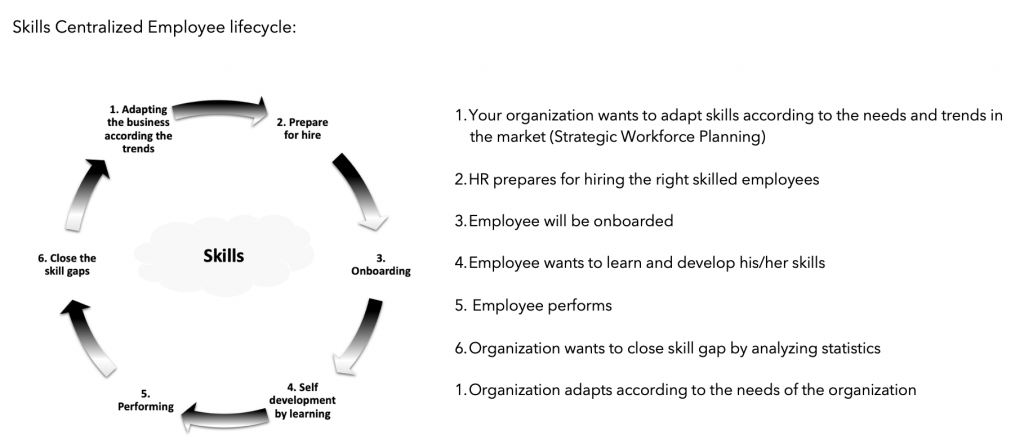Over cookies op deze website Onze websites hebben een aantal cookies nodig om goed te kunnen werken (verplicht). Bovendien kunnen andere cookies met uw toestemming worden gebruikt om het gebruik van de site te analyseren, de gebruikerservaring te verbeteren en voor publiciteit. Raadpleeg voor meer informatie de opties voor uw na te kijken. Door onze website te bezoeken, gaat u akkoord met onze informatieverwerking zoals beschreven in de IBMprivacyverklaring. Om een vlotte navigatie mogelijk te maken, worden uw cookievoorkeuren gedeeld door de hier vermelde IBM-webdomeinen.
Industries
Skills – The New Currency
25/05/2021 | Written by: Helder Silva and Hilda Shalovinsky
Categorized: Cloud | Industries
Share this post:
How does skill volatility affect your organization? Do you know which skills your organization has, and which are missing? Lastly, are you able to provide an end-to-end skills-driven employee experience to your workforce?
The demand for new and different skills and knowledge is continuously evolving at an increasingly rapid pace. Disruptions, from new technology such as AI and automation, combined with the impact of the COVID-19 pandemic, have further amplified the skill volatility that we are facing.
A study by the McKinsey Global Institute estimates that 14% of the global workforce, some 375 million workers, will need to switch occupational categories by 2030. While new jobs are being created, millions go unfilled every year because workers lack the proper training and skills. How does your organization measure up?
The skill gap in organizations
As the gap between the demand for skills by organizations and the supply from individuals continues to grow, relevant skills will increase in value within your organization, making skills our new currency for the future.
Furthermore, attracting individuals with the right skills or desire to learn will involve more than offering the right salary. Employee demands are becoming increasingly varied according to an IBM Institute for Business Value survey. According to employees, the work-life balance (51%), career opportunities (43%) and employer ethics and values (41%) are all more important than compensation and benefits (41%). Continuous learning opportunities followed closely behind (36%).
So, what can organizations and their HR departments do to ensure that they have the skilled workers they need to succeed in the future? And what can employees do to obtain the skills they need to get and carry out their dream job?

Introducing HR 3.0
In order to be in the best possible position to find the right candidates and empower existing employees to train and develop the new skills they need, organizations need HR 3.0 departments. This means HR departments need to reinvent themselves from HR 1.0 and 2.0 to 3.0. IBM research in collaboration with Josh Bersin Academy states that currently only 10% of organizations have achieved HR 3.0.
What does this mean in practice? Traditional HR departments that focus on compliance, administration, and efficient service delivery are HR 1.0, while HR 2.0 involves integrated centres of excellence and focuses on training and empowering business partners to deliver solutions at the point of need. HR 3.0 turns HR into an agile consulting organization that promotes innovative solutions, cognitive tools, and transparency throughout the organization.
The role of skills in HR 3.0
The development of skills and talents within your organization is at the core of HR 3.0. Skills Cloud, an integral part of the Workday HR package, offers 250,000 skills in its remote collection.
Users can add skills from Skills Cloud to their profile as they expand their knowledge and abilities through training or experience. And organizations can see the skills they have available in-house thanks to their employees and where they need to provide additional training and support.
The machine learning-based skills cloud library is universal through all Workday customers. The library is agile and dynamic thanks to the Workday algorithm following market trends and learning more about the relationship between skills over time.

How does Workday help my organization to evolve?
While organizations understand that they need to actively tackle the skills gap, they are often uncertain about where to begin. Skills Cloud from Workday uses a four-step methodology to optimize the organization’s skill management from its HR 2.0 phase.
- Step 1: normalize your data with a universal ontology to bring order, structure, and organization to your talent management as well as helping you to better understand your workforce.
- Step 2: empower your employees to add new skills to their profile. This engages employees with a personalized experience and creates a good habit for future skill development.
- Step 3: enable skill sources to ensure skill verification. Sources include feedback, training courses and webinars, and job experience. The more sources attached to a skill, the more relevant it is. Workday is constantly increasing the range of sources to choose from.
- Step 4: integrate skills in every aspect of your HR programme with the Power of One, Workday’s integrated HR platform. Skills are essential for learning and training, recruitment, HCM, talent management, and more.
Combining Workday with IBM Talent Framework
You can also integrate IBM’s Talent Framework with your core Workday system to give a complementary solution for your organization as part of your strategic skills transformation programme. IBM Talent Framework empowers you to unlock a culture of continuous learning by:
- Leveraging intelligent workflows that bring greater efficiency to managing your workforce;
- Using AI accelerators to better understand your hidden talents; and
- Highlighting how to invest in and develop the skills your organization needs.
Learn more at the IBM Talent Transformation Skills webinar
Interested in discovering how Skills Cloud from Workday can reduce the skills gap in your organization and improve the value of your employees? Want to know how to build a skills-driven organization with a dynamic skills ecosystem at the core of your E2E employee experience? Curious about how Workday and IBM’s Talent Framework work together to create HR 3.0? Join your peers at the upcoming IBM Talent Transformation Skills webinar. As well as discussing Skills Cloud from Workday, industry experts will also cover the capabilities of Strategic Workforce Planning (SWP) and the integration opportunities offered by the IBM Talent Framework.
More information about the webinar will follow soon.
If you would like to discuss Skills Cloud from Workday, contact Helder Silva or Hilda Shalovinsky.

Helder Silva
Workday Lead Benelux @ IBM

Hilda Shalovinsky
Senior Business Transformation/Workday Consultant @ IBM
More Industries stories
IBM-onderzoek: één leverancier voor Cloud is achterhaald
Branche gerelateerde regelgeving wordt gezien als een belangrijk obstakel voor Cloud adoptie door 68 procent van de respondenten. Eén derde van de respondenten ziet security niet als topprioriteit ondanks cyberaanvallen. Uit nieuw wereldwijd onderzoek van IBM (blijkt dat er een drastische verschuiving heeft plaatsgevonden in de zakelijke behoeften van Cloud omgevingen. Slechts één procent […]
Take out complexity and deliver business value with hybrid multicloud
Taking cloud to scale has proven a challenge for many organizations. 60% of European organizations are still running their business-critical application on-premise, and have not yet moved the majority of applications in a hybrid or multicloud architecture, according to IDC’s 2021 Multicloud survey of 925 IT and business decision makers from across Europe from […]
Flemish digital archives available for teachers and pupils, always and everywhere
Meemoo uses Red Hat OpenShift and IBM Cloud to make digital assets of Flemish archives available to more than 65.000 teachers,future teachers and their pupils in Flanders and Brussels Since 2016, meemoo, the Flemish Institute for Archives, makes quality digital assets for educators. It supports the cultural heritage and art organisations in Flanders and Brussels […]






























